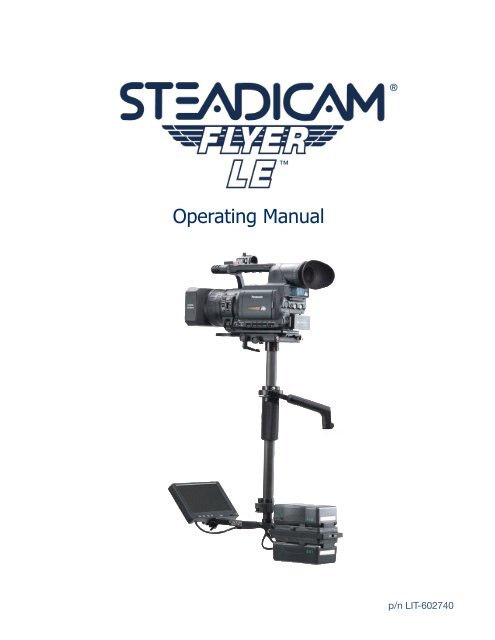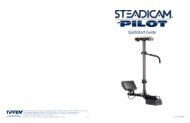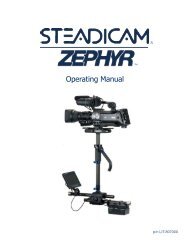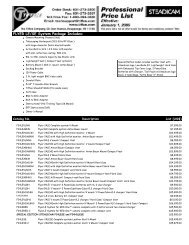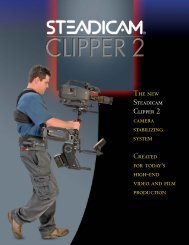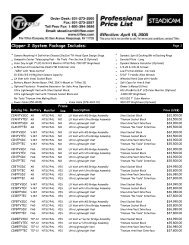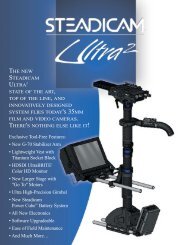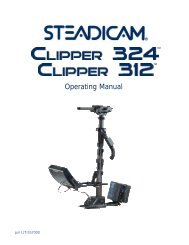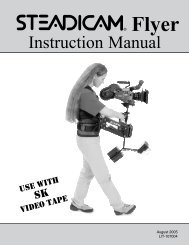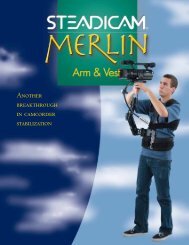Create successful ePaper yourself
Turn your PDF publications into a flip-book with our unique Google optimized e-Paper software.
®<br />
Contents<br />
<br />
<strong>Operating</strong> <strong>Manual</strong><br />
p/n LIT-602740
®<br />
<br />
STEADICAM ® FLYER-LE <br />
<strong>Operating</strong> <strong>Manual</strong><br />
The Tiffen Company, LLC<br />
90 Oser Avenue<br />
Hauppauge, New York 11788<br />
631 273-2500<br />
800 645-2522<br />
631 273-2557 fax<br />
www.<strong>steadicam</strong>.com<br />
<strong>steadicam</strong>@tiffen.com<br />
www.tiffen.com<br />
Technical Support<br />
1-818-843-4600 ext.17<br />
Manufactured in the United States of America<br />
2<br />
© The Tiffen Company, LLC, manual version 4/14/2008 written by J. Holway & L. Hayball
Table of Contents<br />
Overview 4<br />
The Flyer-LE Sled 6<br />
Getting Started 8<br />
Attaching the Camera 10<br />
Balancing 12<br />
The Vest 14<br />
Putting on the Vest 15<br />
The Arm 16<br />
Setting your Threads 17<br />
Picking up the Sled 18<br />
Adjusting the Lift 20<br />
Basic <strong>Operating</strong> 22<br />
Advanced Techniques<br />
Dynamic Balancing 24<br />
Low Mode 26<br />
PowerCube Batteries 28<br />
The Monitor 30<br />
Supplied Accessories 34<br />
Recommended Accessories 35<br />
Cases and Packing 35<br />
This manual is to be used to instruct you in setting up and using your Steadicam ® Flyer-LE . If you have<br />
not already done so, we strongly urge you to take a 2, 3, or 6 day Steadicam ® workshop for the best possible<br />
training and start to your Steadicam ® career (find more information about workshops at www.<strong>steadicam</strong>.<br />
com).<br />
The Flyer-LE is not a push-button magic stick that instantly creates great images. It’s a precision instrument<br />
that responds to your touch. Although it’s not that difficult to operate, it is a skill that takes a bit of time and<br />
effort to learn. The more effort and practice you put into Steadicam ® operating, the better you will be, so it’s<br />
important to develop good habits from the beginning.<br />
Several two-hour sessions will get you started, but an operator can always be more skilled with a Steadicam ®<br />
and also be more effective and artistic in choosing how to start, move, and stop the camera. In the beginning,<br />
it’s helpful and more fun to have a friend work with you. Take turns practicing and spotting for each other.<br />
Use a second video camera to record your exercises – how you stand and move is critical for great operating.<br />
STEADICAM, UltraBrite, and Ultra 2 are registered trademarks of the Tiffen company.<br />
The Tiffen Company, 90 Oser Avenue, Hauppauge, NY 11788 • 631-273-2500 • 1-800-645-2522 • www.tiffen.com<br />
Tiffen Steadicam Operations, Glendale, CA • 818-843-4600 • 1-800-593-3331<br />
3
Tiffen continues to be the industry leader<br />
with the new, affordable<br />
Overview<br />
Camera Stabilization System.<br />
Based on the innovative and<br />
award-winning features of the<br />
Steadicam ® Flyer, the new<br />
Flyer-LE has been further<br />
redefined with upgraded sled<br />
features, an ergonomically<br />
designed vest, a newly designed<br />
stabilizer arm, and an enhanced<br />
battery package system. Stateof-the-art<br />
technology, features,<br />
ease of use, and quality make this<br />
Steadicam ® the perfect choice for<br />
your video and film productions.<br />
New Flyer-LE Sled featuring:<br />
• Robust, 2-section, indexed, carbon fiber, no-tools, extendable<br />
post.<br />
• Index system and increased post diameter assures the<br />
alignment and stability of the sled<br />
• Safety system prevents separation in normal operation<br />
• Friction-free gimbal assembly, now with a larger, knurled<br />
extended handle, fits securely in the operator’s hand<br />
• Precision stage adjustments enable careful balancing of the<br />
camera to the rig<br />
• Operates in standard or low mode<br />
• Kipp ® handle secure locking for the stage and the battery<br />
assemblies<br />
• Proprietary 12 and 24-volt power capability<br />
• 3 pin 12 and 24 volt power connectors<br />
• New design battery mount assembly for easier dynamic<br />
balance adjustment and setup<br />
• 7” NTSC/PAL monitor, standard<br />
• 7” NTSC/PAL 700-nit monitor with FLG optional<br />
4
The Flyer-LE incorporates the same revolutionary Steadicam ® Arm that won the coveted<br />
DV Professional Association’s “Best of Show”:<br />
• Frictionless, silky smooth, double-section arm<br />
• Supports 19 pounds (8.61kg) of camera weight<br />
• Huge, 30” (76cm) lifting range<br />
• Iso-Elastic response for effortless booming and precise vertical control throughout the range<br />
• Open design for a freedom of movement unknown in this weight class.<br />
• Tool-free, one-touch, “on the fly” lift knobs for precise, quick adjustments<br />
• New arm post assembly permits different length arm posts, a feature usually found on more<br />
expensive systems<br />
• 2-section arm separates with a quick release pin for fast and neat storage<br />
Plus:<br />
• New spring design with rounded arm sections • Pinch zone eliminated • No-tools Arm/Vest<br />
interface<br />
Ergonomic new Flyer-LE Vest:<br />
• Based on the comfortable Flyer vest<br />
• New ergonomic breastplate<br />
• Metal shoulder connection with 100% positive vest-to-shoulder clips<br />
• New removable vest and pad covers<br />
• Proprietary, tool-free, arm to vest connector, with two axis arm-to-body angle adjustments<br />
• Stiff front spar and yoke<br />
• Vertical adjustment of socket block for<br />
extended lens height – especially useful in<br />
low-mode<br />
• Socket block mounts left or right<br />
• Two basic vest sizes to fit any operator<br />
All components fit neatly and securely in the<br />
provided custom travel bag, complete with a<br />
sleeve for an optional trolley for ease of transport.<br />
A featured system combines the Flyer-LE with IDX<br />
Dual Charger and two Tiffen PowerCube <br />
batteries. These robust batteries will provide plenty<br />
of amps for any film or video camera.<br />
5
The Flyer-LE Sled<br />
The Flyer-LE Sled<br />
Camera mounting<br />
platform<br />
Stage<br />
connectors<br />
Fore/aft<br />
adjustment<br />
knob<br />
Side to side<br />
adjustment<br />
knob<br />
Post<br />
Post clamp<br />
6
Dovetail lock<br />
Docking<br />
collar<br />
Gimbal<br />
Gimbal<br />
handle<br />
Monitor<br />
bracket<br />
PowerCube <br />
Batteries<br />
Battery mount<br />
7
Prepare the stand and docking bracket<br />
Getting Started<br />
Set up the stand and docking bracket:<br />
• Set up your stand at about chest<br />
height.<br />
• Use one or more sandbags to<br />
stabilize the stand.<br />
• Put the docking bracket on the<br />
stand and tighten the docking<br />
bracket locking knob.<br />
• Push the button at the end of the<br />
aircraft pin and pull the aircraft pin<br />
out of the yoke.<br />
Prepare the sled for the camera<br />
Adjust the monitor position:<br />
• Set the monitor bracket horizontal<br />
• Tilt the monitor to about 45<br />
degrees.<br />
• If the gimbal is not already near<br />
the top of the center post, move it<br />
there.<br />
• Insert the T-handle Allen wrench<br />
into the locking Allen bolt on the<br />
gimbal.<br />
• Loosen the bolt.<br />
• Slide the gimbal to the top of the<br />
center post, but always leave<br />
enough space between the gimbal<br />
and the stage to accommodate the<br />
docking yoke (about 1 inch/25mm).<br />
8
Adjust the battery position and<br />
attach the batteries:<br />
• Rotate the battery mount down at<br />
least 45º.<br />
• Attach both batteries onto the<br />
battery mounts.<br />
use a small screwdriver<br />
to access the switch<br />
In the Flyer-LE , both battery mounts<br />
are active. You can choose 12 volts only<br />
with both batteries in parallel, or 12 and<br />
24 volts – with the batteries in series, via<br />
the two-position switch.<br />
Remove the dovetail from the<br />
stage and set aside:<br />
• Loosen the dovetail locking knob<br />
about one half turn. (If you unscrew<br />
this knob all the way the spring<br />
may pop out.)<br />
• Safety stops on the dovetail and a<br />
safety catch on the sled keep the<br />
dovetail from sliding off the stage<br />
when the dovetail locking knob is<br />
loose.<br />
• Pull the dovetail to the back of the<br />
stage until the safety catch stops<br />
it.<br />
• Pull the safety catch down and<br />
slide the dovetail out of the stage.<br />
• Make sure the safety catch springs<br />
back into its position when the<br />
dovetail is out.<br />
• Take a moment to look at the stage<br />
adjusting mechanism.<br />
• Turn the fore/aft knob. The pinion<br />
engages with the rack on the<br />
dovetail plate.<br />
• Turn the side-to-side adjustment<br />
knob.<br />
dovetail lock<br />
safety catch<br />
Dock the sled in the docking<br />
bracket:<br />
• Hold the sled upright, with the<br />
monitor (front) facing to the left.<br />
Place the center post into the<br />
bracket so the bottom of the stage<br />
rests on the yoke.<br />
• Push the aircraft pin back through<br />
the yoke, securing the post in the<br />
bracket.<br />
safety catch<br />
pinion<br />
side to side<br />
adjustment<br />
knob<br />
fore and aft<br />
adjustment knob<br />
9
Attaching the camera to the sled<br />
Attaching the<br />
Camera<br />
We attach the camera to the sled via a dovetail plate. With the Flyer-LE, this plate has<br />
a rack for adjusting fore-aft balance on the left side, safety stops on the right side, and<br />
several holes for mounting screws. We want to attach the dovetail to the camera so that<br />
we have the widest possible range of adjustment, both fore-aft and side-to-side.<br />
We start this process by finding the<br />
camera’s center of gravity (c.g.) or<br />
balance point, then properly position the<br />
dovetail plate relative to the camera’s c.g.<br />
• If you like, remove the battery from<br />
your camera if it has an auxiliary<br />
power input, either 12 or 24 volts.<br />
With a very heavy camera (15+<br />
pounds/6.8kg or so), this is a good<br />
idea, but it’s not necessary or<br />
advisable with a very light camera.<br />
• Attach all accessories, matte<br />
boxes, obie lights, etc. and load<br />
the tape or film. If the camera<br />
has a quick-release plate (tripod<br />
adaptor), leave it on the camera.<br />
• Balance the camera fore-aft on a<br />
rod or pencil (as shown) and mark<br />
the balance point with a piece of<br />
tape.<br />
• Repeat for side-to-side.<br />
rack<br />
Finding the camera’s fore-aft<br />
center of gravity.<br />
Finding the camera’s side to<br />
side center of gravity.<br />
forward<br />
place this hole<br />
at the c.g.<br />
stops<br />
10<br />
• Examine the dovetail. Turn it over<br />
to locate the rack, the three rows<br />
of large and small slots, and the<br />
stops.<br />
• Remove the screws that are stored<br />
at the front of the dovetail.<br />
• Place the dovetail against the<br />
bottom of the camera (or quick<br />
release plate) and move the dovetail<br />
fore-aft until the Second slot from<br />
the rear is over the camera’s c.g.<br />
This position is not intuitive, so<br />
pay close attention to this detail.
• Now move the dovetail as little as<br />
possible until one or more screw<br />
holes are accessible. Choose<br />
holes as far apart as possible for<br />
maximum stability.<br />
• Insert the screws and tighten with<br />
a screwdriver.<br />
• Insert the dovetail into the back of<br />
the stage.<br />
• Slide it forward until it clicks. If you<br />
encounter resistance, engage the<br />
rack and pinion by gently pushing<br />
the plate forward while turning<br />
the fore-aft knob until the pinion<br />
engages the rack. The fore-aft<br />
knob will now move the dovetail.<br />
• Set the dovetail in the center of<br />
its range of movement. Ideally,<br />
your camera’s c.g. mark should<br />
be about 1/2” (12mm) behind the<br />
centerline of the sled’s centerpost.<br />
• Tighten the dovetail locking knob<br />
securely.<br />
Connect the power and video cables and test<br />
• Connect the BNC to BNC video<br />
cable (use the BNC to RCA<br />
adapter if necessary) from the<br />
camera to the video input on the<br />
back of the stage. If necessary,<br />
choose the camera’s video output<br />
that allows you to watch playback<br />
as well as “live” video.<br />
• If necessary, connect the power<br />
cable by plugging the three-pin<br />
Lemo into the Power output on the<br />
back of the stage and the other<br />
end into the appropriate DC power<br />
input on your camera. Several<br />
power cables are available for<br />
various cameras and voltages. See<br />
the accessories page for the power<br />
cable details.<br />
• Secure the cables with cable ties,<br />
Velcro ® , or gaffer tape. Leave<br />
enough slack for adjustment of the<br />
stage.<br />
• Power up the monitor and camera<br />
to make sure you have a picture.<br />
If you do not, try adjusting the<br />
brightness and contrast controls;<br />
check the cables, battery voltage,<br />
etc.<br />
• Turn off the camera and monitor.<br />
• Camera power connector. 3 pin<br />
LEMO: EGG.0B.303.CLL<br />
• Standard definition (PAL/NTSC)<br />
composite video in. BNC<br />
• Tally connector. 8 pin<br />
• HDSDI video in. BNC (on all Flyer<br />
SE, HD and RED versions)<br />
fore and aft<br />
adjustment knob side to side<br />
adjustment<br />
knob<br />
11
Balancing the sled<br />
Balancing<br />
The Steadicam works, in part, by the careful balancing of components (camera,<br />
monitor, accessories, and battery). We always balance the sled to help us get the shot,<br />
so that the operator does the least amount of work to aim the camera. There are several<br />
components of balance. The first one to work on is “static” balance, where we balance<br />
the sled in all three axes (top-to-bottom, side-to-side, and fore-aft), so that the sled<br />
hangs upright and is not too bottom heavy.<br />
To adjust the balance, we need to put the sled on the docking bracket<br />
balancing stud where it can hang freely<br />
Note: Before letting go of<br />
the sled, be certain that<br />
it will hang more or less<br />
upright. If the sled wants<br />
hang upside down, the<br />
camera weighs more<br />
than 19 pounds (8.6 kg)<br />
and is beyond the weight<br />
specifications of the<br />
Steadicam Flyer-LE.<br />
When balancing a heavier<br />
camera, you may have<br />
to extend the post. While<br />
holding the bottom<br />
of the sled, release<br />
the post clamp and<br />
lengthen the post.<br />
Close the clamp.<br />
Note: changing<br />
the length also<br />
changes the range<br />
of lens heights. This<br />
can be a useful tool<br />
with any weight<br />
camera.<br />
• Pull the aircraft pin and remove the<br />
sled and camera from the docking<br />
bracket.<br />
• Loosen the locking knob of the<br />
docking bracket and turn the<br />
bracket 180 degrees to get the<br />
yoke out of the way. Tighten the<br />
locking knob.<br />
• Place the gimbal’s mounting hole<br />
on the balancing stud.<br />
Top to bottom balance<br />
Let’s start with top-to-bottom balance, as<br />
it is one of the least understood aspects of<br />
balance.<br />
It’s best if the sled is slightly bottom<br />
heavy. Clearly, if it is top heavy, it will<br />
tip over. If it is too bottom heavy, it will<br />
hang upright (a good thing) but be hard to<br />
tilt and very hard to control as you move<br />
around (not good at all!).<br />
If the sled is neutrally balanced (neither<br />
top nor bottom heavy) it’s impossible to<br />
balance the sled fore-aft or side to side,<br />
and the operator must do all the aiming of<br />
the sled – not good either.<br />
So immediately, you should understand<br />
that top-to-bottom balance is a<br />
compromise between competing desires.<br />
If it is just slightly bottom heavy, it can<br />
be both balanced to hang at a particular<br />
angle and easier to control.<br />
How do we get the right top-to-bottom<br />
balance?<br />
First we position the gimbal, which acts<br />
as a pivot point, just a bit above the<br />
center of gravity on the center post, and<br />
here’s how we do that:<br />
• Rotate the center post to<br />
horizontal. Hold it securely.<br />
12
alance point of<br />
the gimbal<br />
• With one hand firmly holding the<br />
camera or the center post, use<br />
the T-handle Allen wrench to<br />
loosen the gimbal locking screw.<br />
Remember to always keep the<br />
post horizontal when the screw<br />
is loosened! Take the wrench out<br />
of the screw but keep it within<br />
reach.<br />
• Grasp the center post and carefully<br />
slide the post in the gimbal. Use<br />
your thumb to push against the<br />
gimbal. Find the place where the<br />
sled is balanced on the gimbal like<br />
a seesaw on a fulcrum. Then slide<br />
the post through the gimbal about<br />
1/2” (12mm) towards the battery.<br />
This will place the sled’s c.g. 1/2”<br />
(12mm) below the gimbal yoke<br />
bearings, and be slightly bottom<br />
heavy.<br />
• Tighten the gimbal locking screw.<br />
Be careful not to over tighten as<br />
the Allen wrench can generate<br />
tremendous force.<br />
WARNING: IF YOU<br />
LOOSEN THE GIMBAL<br />
LOCKING SCREW WHEN<br />
THE CENTER POST IS<br />
VERTICAL, THE WHOLE<br />
SLED WILL DROP<br />
RAPIDLY AND DAMAGE<br />
THE STEADICAM.<br />
Look at the Steadicam from the side. If the sled is tipped up or down:<br />
• Hold the center post vertical.<br />
• Loosen the dovetail locking knob.<br />
• Move the camera forward or<br />
backward by turning the fore-aft<br />
knob until the camera is level. You<br />
can use a bubble level to help you<br />
find vertical.<br />
• Re-tighten the dovetail locking<br />
knob.<br />
Fine tune the side-to-side balance:<br />
• Look at the sled from the front or rear.<br />
Adjust the side-to-side knob on the stage<br />
until the center post is vertical. Again, you<br />
can use a bubble level to help you find<br />
vertical.<br />
fore and aft<br />
adjustment<br />
knob<br />
Now we are ready to fine-tune the top-to-bottom balance by using the<br />
“drop time” test<br />
• Make sure the dovetail locking knob is tight.<br />
• It’s good to have our assistant hold the stand.<br />
• Rotate the sled to horizontal. • Let go of the center post.<br />
• Count how many seconds it takes the center post to fall to vertical.<br />
side to side<br />
adjustment<br />
knob<br />
If the rig has a drop time of less than two seconds it is too bottom heavy. You need to<br />
move the sled’s c.g. upwards, closer to the gimbal. If the drop time is more than two<br />
seconds, move the sled’s c.g. lower, further from the gimbal:<br />
• With the rig horizontal, loosen the clamp and slide the centerpost though<br />
the gimbal about 1/8” (3mm) in the proper direction.<br />
• Re-tighten the gimbal locking screw.<br />
• Re-do the drop test. Keep making small adjustments until the sled has a 2<br />
second drop time.<br />
• Recheck the fore-aft and side-to-side balance by looking at the sled. Trim<br />
with the fore/aft and side-to-side knobs as necessary.<br />
Note: A drop time of 1 to 4 seconds might be best for a<br />
particular shot. You will eventually determine what works<br />
best for you for average shooting, and what works best for<br />
you for each shot. But let’s start with a 2 second drop time.<br />
We will fine-tune top to bottom balance<br />
after we get close to fore-aft and side-toside<br />
balance. We may need to fine-tune<br />
each axis as we balance in another axis,<br />
and we get closer to the perfect balance<br />
for the shot.<br />
13
The Vest<br />
The Vest<br />
Shoulder<br />
connector<br />
Shoulder<br />
pads<br />
Adjustable<br />
spar<br />
Chest plate<br />
release pin<br />
Chest pads<br />
Chest<br />
connectors<br />
Adjustable<br />
velcro ® straps<br />
Hip<br />
pads<br />
Socket block<br />
Socket block<br />
height adjustment<br />
14
Putting on the Vest<br />
Please read the vest instructions<br />
completely before you try to put the vest<br />
on. It is very helpful to have a friend help<br />
you the first time you put on the vest.<br />
Otherwise use a full-length mirror.<br />
• Pull out the chest plate release pin<br />
and adjust the center spar up or<br />
down so the hip pad sits centered<br />
on your hips. Replace the chest<br />
plate release pin in the nearest<br />
hole.<br />
Open the vest<br />
• Loosen both chest straps.<br />
• Release the hip straps on the left<br />
side.<br />
• Open the chest buckle on the left<br />
side.<br />
• Open the shoulder buckle on the<br />
left side.<br />
• Slip the vest on.<br />
• Close the shoulder buckle.<br />
• Be sure the Velcro ® straps are<br />
horizontal on the hip pads, and<br />
tighten the hip straps completely<br />
and evenly.<br />
• The vest should be very snug,<br />
but not uncomfortable. Adjust the<br />
straps as necessary.<br />
Removing the vest<br />
The vest should be unbuckled on the left<br />
side only, from bottom to top:<br />
• Undo the hip strap first.<br />
• Undo the chest buckle.<br />
• Undo the shoulder buckle and<br />
slip out of the vest. When you<br />
put it back on, you will not need<br />
to readjust the chest plate or the<br />
chest straps.<br />
Pay close attention to the good<br />
fit of the vest in the photo<br />
above. It’s very important how<br />
the shoulder pads contact the<br />
shoulders and the shoulder<br />
connectors are not too high (a<br />
common mistake).<br />
• Close the chest buckle.<br />
• Center the chest plate on your<br />
chest.<br />
• Tighten the chest straps evenly<br />
and secure the loose, Velcro ® ends.<br />
• Push down on the chest plate to<br />
seat the shoulder pads on your<br />
shoulders.<br />
Note: A few operators have body shapes<br />
or sizes that are out of the general range<br />
of adjustments. You may find you have to<br />
add or remove padding, shorten or extend<br />
straps, etc. to make the vest fit perfectly.<br />
15
The Arm<br />
The Arm<br />
Forearm section<br />
Arm post<br />
Upper arm section<br />
pin to<br />
separate arm<br />
for packing<br />
lift adjustment<br />
knob<br />
Arm post<br />
release<br />
screw<br />
Socket quick<br />
release pin<br />
Rod ends<br />
lift<br />
adjustment<br />
knob<br />
Double action hinge<br />
Steel<br />
springs<br />
Socket<br />
Mounting the arm to the vest<br />
The arm mates with the vest via an<br />
adjustable socket in the arm and a<br />
female socket block on the vest. The two<br />
adjustment screws in the socket block on<br />
the vest and two “rod ends” in the mating<br />
section of the arm determine the lift angle<br />
of the arm. These two adjustments are your<br />
“threads,” and they are specific to your<br />
body size and shape. Setting your threads<br />
correctly is critical for good operating.<br />
16<br />
Some combination of adjustment of<br />
these screws – and your physique and<br />
posture – will make the arm lift straight<br />
up when carrying the sled. The angles<br />
of adjustment are not directly “in-out”<br />
and “side-to-side”, but rotated about<br />
30 degrees clockwise (relative to the<br />
operator). We will suggest approximate<br />
threads to start, but the only real way<br />
to test your threads is to pick up the<br />
Steadicam and see what happens. You<br />
can’t set your threads fully without<br />
picking up the Flyer.<br />
The arm socket is inserted into<br />
the socket block on the vest.
Determining your threads is part of basic operating technique<br />
Adjusting your threads<br />
For almost all operators, regardless of<br />
body type, the typical adjustment for the<br />
“side-to-side” screws (the rod ends in<br />
the arm) is 1.5 to 2 turns out on the top<br />
screw and ALWAYS all the way in on the<br />
bottom screw.<br />
Use the rollers when the arm is not<br />
under load. If you are flying the sled,<br />
lift it up with your left hand to take the<br />
weight off the screws before adjusting<br />
them. The two side-to-side screws work<br />
independently of one another. Do not<br />
tighten the lower screw, but be sure it is<br />
all the way in, and then back it out 1/8th<br />
of a turn.<br />
The “in-out” screws work in tandem,<br />
and the adjustment varies greatly by the<br />
operator’s body type.<br />
side-to-side: 2<br />
turns out on top<br />
in-and-out: count<br />
threads here<br />
• If you have big pectorals and a flat<br />
stomach, the top screw is almost<br />
all the way in. If you’ve been eating<br />
well and exercising less, the top<br />
screw will be further out.<br />
• Always dial in the top screw first<br />
to your setting, then turn in the<br />
bottom screw until it just snugs up<br />
against the fitting. There is no need<br />
to tighten the bottom screw very<br />
hard.<br />
• Always keep a hand on the free<br />
end of the arm, otherwise it might<br />
swing around and hit something,<br />
someone, or you in the face.<br />
• With both pairs of screws properly<br />
adjusted, the Flyer-LE will float<br />
in all positions with the operator<br />
standing in good posture with a<br />
vertical torso. If the threads are not<br />
adjusted well, the sled will tend to<br />
fly or fall away from you.<br />
Goofy foot<br />
If you want to operate “goofy-foot,” – with the sled on the right side – you will<br />
need to reverse the socket block before starting.<br />
• On the vest, loosen the four screws holding the socket block in place.<br />
Flip the block 180° and re-attach (above).<br />
• On the arm, unscrew the rollers until the socket separates completely<br />
from the arm. Turn it over and re-attach (right).<br />
• Set the top screw about two turns out, and the bottom screw all the way in.<br />
17
Picking up the<br />
Sled<br />
1 2 3<br />
Undocking, setting your threads, and docking the sled<br />
With the vest on and the arm attached to the vest, undock the rig:<br />
• Face the sled and bow at the<br />
waist. Do not bend your knees. It<br />
is helpful to have a friend spotting<br />
you the first time you do it.<br />
• Align the gimbal mounting hole<br />
to the arm post and slip the arm<br />
post completely into the hole. It’s<br />
easiest to align the parts if the<br />
gimbal handle is positioned behind<br />
the rig (i.e., not to the side, aimed<br />
at you).<br />
• Use your right hand to hold the<br />
arm and gimbal together (frame 4,<br />
above).<br />
• Place your left hand on the center<br />
post just below the gimbal to<br />
control the Steadicam. Do not<br />
touch the camera (frame 4, above).<br />
• Step forward and stand up straight.<br />
You are now flying the Steadicam,<br />
but still locked in the dock.<br />
• Pull the aircraft pin out of the<br />
docking yoke (frame 6, above).<br />
• Step back from the stand to<br />
remove the sled from the docking<br />
bracket.<br />
• Take a deep breath. Relax.<br />
• Move the sled to a position about<br />
45º off your left hip as shown.<br />
• Aim the sled slightly across your<br />
body (frame 9, above).<br />
18
4 5 6 7 8 9<br />
Holding the Steadicam might feel awkward at first. Don’t<br />
worry – you will gain control and endurance rapidly as<br />
you practice. The first time is typically the most annoying,<br />
because there are so many adjustments to make before<br />
it all falls into place and “magically” works with you. It<br />
may be that you will want to adjust the lift capacity of the<br />
arm (see pages 20-21) before fine-tuning your threads.<br />
Eventually you must adjust them both.<br />
Test your threads<br />
• Stand as upright as possible, in<br />
good posture, with the rig off your<br />
left hip. Don’t be stiff or tense. Do<br />
not ever let go of the Steadicam<br />
completely, but let it move a little.<br />
• If it tends to stay in place, try<br />
moving it further out in front of you.<br />
Lean back a little as you feel the<br />
vest pushing against your stomach<br />
and pulling your torso forward. The<br />
trick is to lean a little bit away from<br />
the rig – more if it’s further from<br />
you, less as it’s closer to you – so<br />
that the sled wants to stay in place<br />
or float next to you.<br />
• If the sled wants to move off in<br />
one direction rather dramatically<br />
and you can’t lean forward or back<br />
easily to correct it, you need to<br />
adjust your threads. Typically it’s a<br />
matter of the “in-out” screws rather<br />
than the side-to-side screws.<br />
• If the sled wants to move away<br />
from you, loosen the bottom in-out<br />
screw and dial in the upper screw<br />
a few turns. Snug up the lower<br />
screw and re-test.<br />
• If the sled wants to move towards<br />
you, loosen the upper in-out screw<br />
a few turns, snug up the lower<br />
screw, and re-test.<br />
• Do not get too fussy with your<br />
threads at this point, as much of<br />
the trick is learning to properly<br />
stand and move, rather than<br />
adjusting your threads.<br />
• Take a few steps and experiment<br />
with the feel of it all. Try panning<br />
and tilting. Before you get tired,<br />
dock the sled.<br />
Practice replacing the sled in<br />
the docking bracket<br />
• Step up next to the docking stand<br />
with the camera aimed to the left.<br />
• Insert the center post in the<br />
bracket and rest the stage on the<br />
docking yoke.<br />
• Insert the aircraft pin back in the<br />
docking yoke to secure the sled<br />
• Bow from the waist and step back<br />
• Move your left hand to the gimbal<br />
handle, and your right hand to the<br />
arm.<br />
• Hold up the gimbal handle and<br />
let the arm post slide out of the<br />
gimbal mounting hole. Don’t force<br />
it or bend your knees; just find the<br />
correct angle so that the arm post<br />
slips out of the gimbal.<br />
• Always keep a hand on the free<br />
end of the arm, otherwise it might<br />
swing around and hit something.<br />
• Rest. Stretch.<br />
• When you don’t have time to dock<br />
and undock, you can relieve some<br />
muscle tension by holding the rig<br />
close to your body on either side<br />
or clasping the camera close to<br />
your chest.<br />
19
Setting the lift capacity of the arm<br />
Adjusting the Lift<br />
The arm tension is adjusted at the factory for the heaviest camera it can hold so the<br />
arm does not bottom out when you put the camera and sled on the arm for the first<br />
time. Now it’s time to adjust the arm for the weight of your camera.<br />
Important: The lift<br />
adjustment knobs can<br />
only be turned when the<br />
arm segments are slightly<br />
above horizontal. They<br />
cannot be turned when<br />
the arm is unloaded, i.e.,<br />
when not lifting the Flyer-<br />
LE, nor if the arm sections<br />
are boomed too far up or<br />
down. Do not force the lift<br />
knobs. At the right angle,<br />
they turn very easily.<br />
Adjusting the arm<br />
• With the vest on, attach the arm<br />
and undock the rig as before.<br />
• Stand with the sled off your left<br />
hip, with the lens slightly crossing<br />
your body.<br />
• Move the arm to the middle of its<br />
boom range and let it rise or fall.<br />
Do not completely let go of the<br />
sled.<br />
• Turn the weight adjustment knob<br />
clockwise until the forearm wants<br />
to float at this angle.<br />
• Keep making small adjustments<br />
until the forearm settles at a 5º<br />
angle up from horizontal.<br />
20<br />
• Ideally, each section of the arm<br />
should come to rest slightly above<br />
horizontal, about 5º.<br />
• Adjust the arm section nearest the<br />
sled first (the forearm section).<br />
• If the arm floats at too high an<br />
angle, pull the sled down with your<br />
left hand until the forearm section<br />
is about 5º above horizontal.<br />
Turn the weight adjustment knob<br />
counterclockwise until the forearm<br />
wants to float at this angle.<br />
• If the arm floats at too low an<br />
angle, pull the sled up with your<br />
left hand until the forearm section<br />
is about 5º above horizontal.<br />
•Repeat the process with the upper<br />
arm section, but this time try to get<br />
the upper arm to follow the forearm<br />
as you boom up and down.
CAUTION: IF YOU REST YOUR RIGHT HAND ON THE<br />
CONNECTING ARM, KEEP YOUR FINGERS OUT OF THE<br />
SPACE BETWEEN THE ELBOW AND THE ARTICULATING<br />
ARM. A SUDDEN RISE OF THE CAMERA COULD INJURE<br />
YOUR FINGERS IF THEY ARE IN THIS SPACE.<br />
• Remember, the weight adjustment<br />
knob turns freely when the arm<br />
section is slightly above horizontal.<br />
Never force it or use a tool to<br />
adjust the arm lift.<br />
Now let’s fly the rig again<br />
• Move the sled off your left hip<br />
as before. Keep the camera<br />
close. This is what we call the<br />
“Missionary.”<br />
• Move your torso ever so slightly to<br />
test how your body angle controls<br />
the Steadicam.<br />
• Repeat with the sled further away<br />
from you, but keep your torso<br />
vertical.<br />
• The sled should stay in place with<br />
only a little help from your right<br />
hand.<br />
Boom the sled up and down while watching the arm sections.<br />
The upper arm should follow the forearm —no arm section<br />
should lag behind the other.<br />
21
Hand grips<br />
Basic <strong>Operating</strong><br />
The two-handed technique was invented<br />
by Garrett Brown while working on The<br />
Shining, and it has been the preferred<br />
method of operating ever since.<br />
Basically, the right hand does the work<br />
of positioning the sled in space (moving<br />
horizontally and vertically relative to the<br />
body), and the left hand aims the sled<br />
(and therefore the camera) by panning<br />
and tilting.<br />
If the Flyer-LE is properly balanced,<br />
very little force will be needed to aim<br />
the camera. Clenching the center post<br />
or gimbal hard will counteract the<br />
Steadicam’s “float.” Light control is<br />
the key to a steady camera and smooth<br />
moves.<br />
The left hand also has the interesting job<br />
of keeping the sled level as we move<br />
about. As we accelerate or decelerate,<br />
go around corners, etc., the left hand<br />
must prevent the sled from going offlevel<br />
before it happens. One of the big<br />
Steadicam operating skills is anticipating<br />
how the sled will behave as we move<br />
along. There are several classic “grips”<br />
we use to aim and control the sled.<br />
Finding your grip<br />
• Grab the center post with your left<br />
hand just below the gimbal. All<br />
five fingers should be LIGHTLY in<br />
contact with the post, but this isn’t<br />
a tea party. Don’t just use your<br />
fingertips – wrap you fingers a bit<br />
around the post.<br />
• The right hand fine tunes the<br />
position of the Steadicam,<br />
moving it side-to-side or closer<br />
to or farther from your body, and<br />
booms the arm up and down. It<br />
also has the job of eliminating<br />
the bounce of the springs – i.e.,<br />
preventing unwanted up and down<br />
movements as you move along.<br />
• Grab the gimbal handle with your<br />
right hand.<br />
• Make sure that this hand does not<br />
cross the bearing and touch any<br />
part of the Y-shaped yoke, as this<br />
will influence the aiming of the<br />
sled.<br />
22<br />
The preferred grip, using the pinkie<br />
finger to prevent a pendulum effect.<br />
Full hand grip. All fingers surround the<br />
post with a light touch.
Basic movement<br />
Practice moving around in the Steadicam<br />
and get used to the way it feels. Walk<br />
around. Pay attention to the way your<br />
movements and posture affect the<br />
Steadicam.<br />
Relax your muscles and control the Flyer-<br />
LE with your body position and a light,<br />
finger-tip touch.<br />
Leave the monitor off for now. Don’t<br />
worry about making shots – you want to<br />
experiment, test, play.<br />
Get used to walking with the Steadicam<br />
next to you.<br />
Balancing with your body<br />
As the Steadicam gets farther away from<br />
your body, you must lean back a tiny bit<br />
more and use your arm reach to keep that<br />
light balanced touch.<br />
If you lean forward, the Steadicam will<br />
try to move away from you — fast!<br />
— requiring a firmer grip, tiring your<br />
back muscles more quickly, and most<br />
importantly, not flying properly with that<br />
great Steadicam feel.<br />
Placing the camera in space<br />
Swing the arm around to find its range<br />
of motion. Practice gentle boom moves<br />
with your right hand. Find the lowest and<br />
highest positions the camera can reach.<br />
Avoid hitting the stops as you boom (it<br />
won’t hurt the Steadicam, just your shot).<br />
More Practice and Training<br />
For operators who have not yet taken a workshop, we (once again!) strongly urge you<br />
to do so, as it is the quickest way to learn how to operate a Steadicam properly.<br />
However, there are several good training videos, including the 1990 Classic EFP<br />
Video Training Tape, which has been remastered to DVD. Although some of the<br />
information on the EFP video is specific to the EFP, most of the concepts, information,<br />
and exercises are common to all Steadicams and still taught in the workshops today.<br />
We suggest you spend some time with your Flyer-LE learning how to start and stop<br />
moves cleanly, pan and tilt, boom up and down, walk the line, do switches, track<br />
sideways, do pass-bys, use long lenses, and a host of other techniques.<br />
You already know what you want to do<br />
with your Flyer-LE. The exercises and<br />
concepts presented on the video will help<br />
you quickly develop the necessary skills<br />
to make your shots.<br />
As often said in the workshops, running<br />
around chasing your dog is fun for<br />
awhile, but it’s hard to judge how well<br />
you did or if you are improving.<br />
Many experienced Steadicam operators<br />
are still perfecting their moving camera<br />
skills after 25 years of operating, and<br />
most of them thought they were pretty<br />
good at the end of their first workshop.<br />
How good you get is part of the artistry<br />
and fun of being a Steadicam operator.<br />
You have a great tool in your hands.<br />
Practice, practice, practice.<br />
23
Dynamic Balancing the Flyer-LE <br />
Dynamic Balancing<br />
A Steadicam sled is in dynamic balance<br />
when the center post remains vertical as<br />
the sled is panned (and this is critical) at<br />
any and all panning speeds.<br />
Dynamic balance is extremely important<br />
for precise operating and also for whip<br />
pans.<br />
For each arrangement of camera, monitor<br />
position, post length, accessories, etc.,<br />
there are many possibilities for statically<br />
balancing the Steadicam.<br />
However, for each arrangement of<br />
camera, monitor position, post length,<br />
accessories, etc., there is only one<br />
combination that balances the sled both<br />
statically and dynamically. There is some<br />
leeway as to the required precision of<br />
dynamic balance. What is acceptable<br />
depends upon the operator and the<br />
situation.<br />
Dynamic balance with the Flyer-LE can<br />
very easily and quickly be achieved by<br />
the trial and error method.<br />
In all cases, when a sled is in dynamic<br />
balance, both the camera’s c.g. and the<br />
battery’s c.g. will be to the rear of the<br />
centerline of the center post. This rule<br />
gives you some point to begin balancing<br />
the Steadicam.<br />
Three figures to study for understanding dynamic balance<br />
The top figure looks like the Model One or the SK Steadicams. The camera c.g. is<br />
centered over the post; the monitor and battery are on the same horizontal plane, and<br />
their common c.g. is in the post. This unit is in dynamic balance and pans flat.<br />
The second figure has the monitor raised a bit. This looks like most Steadicam<br />
configurations, including the Flyer-LE, in either high or low mode. Note that the battery<br />
c.g. is closer to the post, and the camera c.g. has moved to the rear. Why?? See the third<br />
figure.<br />
M<br />
B<br />
In the third figure, the monitor has been raised all the way up in front of the camera. It’s<br />
absurd, of course, but it makes a point. Now the common monitor and camera c.g. is over<br />
the post, and the battery’s c.g. is directly under the post.<br />
M<br />
So you can see that as the monitor is raised, the camera c.g. must move to the rear and<br />
the battery c.g. must move towards the post. With the Flyer-LE, the monitor is typically<br />
raised above the battery – and with 2 batteries, the monitor must be above the battery for<br />
dynamic balance. Therefore camera is always to the rear of the centerpost.<br />
It typically works out that the camera c.g. is pretty close to 1/2 inch (12mm) to the rear –<br />
a bit more if the camera is light or the monitor is higher, and somewhat less if the camera<br />
is very heavy or the monitor is lower.<br />
M<br />
B<br />
B<br />
24
We put the rig in dynamic balance by<br />
first choosing the monitor position and<br />
then placing the camera close to its final<br />
position. By trial-and-error, we then<br />
discover the one-and-only ideal position<br />
for the battery.<br />
First, set up your sled at the proper<br />
length for the shot and place the monitor<br />
where you want it for proper viewing<br />
and inertial control. Typically with the<br />
Flyer-LE, the monitor will be horizontal,<br />
for maximum pan inertia. Position the<br />
camera so that its c.g. is about .5 inches<br />
(12mm) behind the center post. The<br />
center post is 28mm in diameter, so you<br />
can use the back of the post as a guide.<br />
Next, static balance by rotating the<br />
battery down from horizontal (your<br />
only choice) so the sled hangs perfectly<br />
vertical fore and aft. Make sure the topto-bottom<br />
balance is set with a drop time<br />
of 2 seconds.<br />
Trim side to side with the camera, using<br />
the knobs on the stage. Fine-tune the<br />
fore-aft balance with the camera. You<br />
want the sled perfectly vertical.<br />
Give the sled several careful test spins.<br />
Very important: do not spin the rig very<br />
fast – certainly not much faster than a<br />
normal panning speed (3 – 6 rpm). Note<br />
the results. Is it good or bad, i.e., panning<br />
flat or wobbly? Is it your technique or is<br />
the sled out of dynamic balance?<br />
you are in static balance, spin the sled<br />
again. Is it better or worse? Again, you<br />
have two choices for moving the battery.<br />
Re-rack, rebalance, and spin again (and<br />
again!) until the sled pans flat. This<br />
should not take a lot of time.<br />
When the battery is within about 1/4<br />
inch (6mm) of ideal, the sled will behave<br />
nicely – pan flat – and feel “sweet.” We<br />
suggest you do not attempt to do this for<br />
the first time on set!<br />
Adding any accessory to the sled will<br />
affect both static and dynamic balance.<br />
Changing the length of the sled, and/or<br />
moving the monitor in, out, up, or down<br />
will change both static and dynamic<br />
balance.<br />
How much will dynamic balance change?<br />
It depends on the mass and position of the<br />
new object, and the masses and positions<br />
of everything else on the sled.<br />
You will discover that as the monitor is<br />
placed higher towards the camera (and<br />
inwards), the closer the battery c.g. gets<br />
to the center post, and the more the<br />
camera c.g. moves away from the post to<br />
the rear.<br />
With both batteries installed for 24 volts,<br />
it may be impossible to raise the monitor<br />
Dynamic balance spin test with an Ultra 2<br />
from horizontal — unless you add some<br />
weight to the monitor. Adding weight<br />
to the monitor (about a pound) will also<br />
increase the inertia and give your Flyer-<br />
LE a more stable feel.<br />
In practice, it’s a lot easier than it sounds<br />
on the page, and luckily, there’s one<br />
great gift in all this: it doesn’t matter for<br />
dynamic balance what weight camera you<br />
are using or if you change lenses, filters,<br />
etc. Really!<br />
So if you make any changes with the<br />
camera – or use a different camera –<br />
there are no worries about getting back<br />
in dynamic balance! You only need to<br />
rebalance statically and you will be in<br />
dynamic balance again. Honest.<br />
Put the other way around: you can set up<br />
your rig in various ways with a practice<br />
camera at home, making it long or<br />
short, monitor high or low, with an extra<br />
weight, etc. Note the positions of the<br />
monitor and batteries, and you will be<br />
able to get into dynamic balance quickly<br />
on set, regardless of the camera you<br />
carry. Really. Honest. No fooling.<br />
For the complete story, see the Dynamic<br />
Balance Primer and play with the<br />
Dynamic Balance Spreadsheet, available<br />
online at www.<strong>steadicam</strong>.com.<br />
If your Flyer-LE is not in dynamic<br />
balance, do not move the monitor!<br />
Instead, move (rotate) the battery a little<br />
bit first, then rebalance statically with the<br />
camera. There are only two directions to<br />
move the battery, out or in (which is also<br />
up and down). You have a 50% chance<br />
of choosing the right direction, so stop<br />
worrying about it and give one direction a<br />
test. Just be sure to make a note of which<br />
direction you move the battery.<br />
After you lock the battery in place, you<br />
must rebalance the sled statically with the<br />
camera. Do not move the monitor! Once<br />
Spinning a bit wobbly.<br />
Looking good!<br />
25
Configuring the sled for low mode<br />
Low Mode<br />
In order to configure the sled for<br />
low mode operating, you must:<br />
• Flip the monitor and the camera<br />
upside-down.<br />
• Attach the F-bracket to the gimbal.<br />
Use the provided safety pin.<br />
• Rebalance the sled, both statically<br />
and dynamically.<br />
• You also might change to a longer<br />
post in the arm and/or raise the<br />
socket block on the vest to restore<br />
some of the arm’s lost boom range.<br />
The camera will need some means<br />
of attaching a second dovetail (P/N<br />
601-7412) to the top of the camera.<br />
Many film cameras come with dedicated<br />
low mode brackets and 100% video<br />
viewfinders. Some camera-specific low<br />
mode bracketry might also provide<br />
a means of mounting motor rods (or<br />
a dovetail with motor rods), and this<br />
system should not interfere with camera<br />
functions or working with the camera in<br />
high mode.<br />
A low mode handle clamp (P/N 078-<br />
7393-01) works for some cameras, but<br />
be sure the camera’s handle is strong<br />
enough. Many plastic handles on video<br />
cameras are inadequate, and a custom<br />
cage or bracket is required.<br />
Most operators work with the low mode<br />
bracketry and second dovetail in place —<br />
ready to go at all times.<br />
Attach the second dovetail directly above<br />
the first dovetail. Check that it does not<br />
interfere with changing tapes, film mags<br />
or any other camera functions.<br />
26
Tip: Many video cameras – or video cameras with film lens<br />
adaptors – do not have a proper way to mount a dovetail<br />
above the camera. We suggest you use the “bottom”<br />
dovetail for low mode, shooting upside down. You will need<br />
to flip the image in post production, so be sure that’s okay<br />
before you shoot. You can either leave the monitor upside<br />
down, or physically flip it over for better viewing. The latter<br />
will require electronic flipping of the image.<br />
Flip the monitor by unscrewing the<br />
monitor mount, turn the monitor over and<br />
replace the screw.<br />
Attach the f-bracket to the gimbal handle<br />
by inserting the post into the gimbal<br />
handle and securing it with the pin. The<br />
F-bracket brings the arm back into a<br />
proper relationship with the inverted sled.<br />
Without an F-bracket, the end of the arm<br />
can be next to the camera. When this<br />
is the case, switches are impossible and<br />
operating is severely limited.<br />
Balancing on the stand with<br />
the f-bracket attached.<br />
Balance the Steadicam ®<br />
The sled can be balanced the same as in<br />
high mode. Hang the rig by its gimbal<br />
on the balancing stud. The camera will<br />
still be on top, but it is upside down.<br />
Balance statically and dynamically. Once<br />
balanced, adjust your drop time so the<br />
camera now falls to the bottom of the<br />
rig: simply slide the gimbal towards the<br />
electronics to achieve a proper drop time.<br />
Cautionary Tip: In low mode, the dovetail<br />
lock works better if the camera weight is<br />
supported as you lock the dovetail.<br />
A useful trick<br />
The range of low mode lens heights<br />
can be lowered by extending the center<br />
post and/or making the rig more bottom<br />
heavy.<br />
Low mode operating<br />
Traditionally, it’s considered harder to<br />
operate in low mode than in high mode.<br />
Why?<br />
Several factors may work together to<br />
make low mode operating harder. The<br />
operator usually holds the sled further<br />
from his body than in high mode. The<br />
operator’s hands are not at the same<br />
height. Many times, the post is tilted from<br />
vertical. The boom range is sometimes<br />
reduced. The rig may not be in dynamic<br />
balance. The operator often cranes his<br />
neck to see the image. In addition, every<br />
director wants the lens height lower or<br />
higher than one can properly reach. And<br />
it’s just plain weird to have the monitor<br />
so far above the lens.<br />
Hand positions for operating<br />
with the f-bracket.<br />
27
PowerCube Batteries and the Flyer-LE <br />
Batteries<br />
The PowerCube batteries are rated at 6.0<br />
Ah, 14.8V. Please read the literature that<br />
comes with each battery and charger for<br />
details.<br />
Generally we use the batteries in pairs,<br />
generating (nominally) 29.6VDC<br />
in series (24V setting of switch), or<br />
13.8VDC in parallel (12 volt setting of<br />
switch).<br />
It’s best to use batteries that are roughly<br />
equally charged. In the 24 volt mode, one<br />
battery is “tapped” to also provide 12<br />
volts at the power connectors.<br />
For a lightweight, 12 volt running rig,<br />
you might want to remove a battery,<br />
and/or use one Endura 7 or compatible<br />
battery. Use two smaller batteries for a<br />
lightweight 24 volt rig.<br />
Discharge rate<br />
As your Lithium-Ion PowerCube<br />
batteries are used, the voltage drops<br />
at a fairly regular rate. However, the<br />
sample 30 watt discharge chart shows<br />
some interesting information. Hot off<br />
the charger, a single battery will read<br />
16.8 volts, but within a minute drops<br />
to 16.1 volts when under load. This is<br />
normal, and not a cause for concern or an<br />
indication of a weak battery.<br />
At the 30 watt discharge rate, the battery<br />
voltage drops slowly for about 3 hours<br />
from 16.1 volts to the “knee” voltage of<br />
13.8 volts – slightly faster at the upper<br />
end, and more slowly as the battery is<br />
discharged. When the voltage reaches<br />
13.8 volts, the voltage drops off very<br />
quickly to 11 volts (within 8 minutes).<br />
The batteries have a self-limiting cut-off<br />
of 11 volts.<br />
If the voltage drops below 26 volts when<br />
the camera is not running, you will not<br />
get any appreciable run time with most<br />
35mm, 24 volt film cameras.<br />
Charging your batteries<br />
There is no memory effect with Lithium-<br />
Ion batteries. There is also no need to<br />
deep discharge your batteries to improve<br />
their response. Charging a completely<br />
discharged battery (11 volts) to fully<br />
charged (at 16.8 volts) with a 3.0 amp<br />
charge takes about 2 hours and 40<br />
minutes, but the battery reaches 80% of<br />
a full charge (at about 16.5 volts) in just<br />
over 90 minutes. The last 20% of the<br />
charge cycle takes over an hour.<br />
We suggest that if you have the time,<br />
fully charge your batteries. If you are in a<br />
hurry, however, charge them only for an<br />
hour and a half or less, as an 80% charge<br />
of these batteries is still a lot of watthours,<br />
and typically you are using two of<br />
them. Also don’t discharge them much<br />
below 13.8 volts if possible.<br />
Note: If you have the optional VL-<br />
4S charger, all batteries are charged<br />
simultaneously. With one, two, or three<br />
batteries on the charger, the charge<br />
current is 3.0 amps per battery. When the<br />
fourth battery is added to the charger, the<br />
charge current for each battery drops to<br />
2.3 amps, which will increase the time it<br />
takes to charge each battery.<br />
28
Discharge Characteristics of PowerCube<br />
17<br />
16<br />
15<br />
Voltage [V]<br />
14<br />
13<br />
12<br />
11<br />
Discharge Condition: 30W, 11V (EDV)<br />
Ambient Temp.: Room Temp.<br />
Discharge Time: 184.6min (92.3Wh)<br />
10<br />
0 20 40 60 80 100 120 140 160 180 200<br />
Elapsed Time [min]<br />
29
Standard 7” Color LCD Monitor<br />
p/n 602-7500<br />
The Monitor<br />
Monitor<br />
lock<br />
7” color LCD monitor with optional frameline generator<br />
p/n 302-7500-01 (available on the SE version - see opposite page for specs)<br />
30
PWR (Power ON/OFF)<br />
Press this button to turn the monitor on/off.<br />
When the power is on, the LED on monitor will light up.<br />
SEL (Menu Selector, AV1/AV2 Selection)<br />
1. Long press this button to switch menus. The cycle is as<br />
follows.<br />
BRIGHT!CONTRAST!COLOR!TINT!DIMMER!<br />
LEFT/RIGHT!UP/DOWN!SAFETY!DEFAULT<br />
2. Short press this button to switch AV1/AV2 mode.<br />
DISP (Display Mode)<br />
Press this button to switch 4 types display mode: Full Mode,<br />
Normal Mode, Wide Mode, Zoom Mode.<br />
Note: Under menus, press this button to turn off the OSD<br />
menu immediately.<br />
NTSC/PAL Auto Selection<br />
This monitor can detect and switch between NTSC/PAL video<br />
standards automatically.<br />
SAFETY MODE<br />
Note: The SAFETY mode in this monitor is a reserved feature and is<br />
factory set to OFF.<br />
To Disable the SAFETY MODE use the following steps:<br />
1.Make sure this monitor is in the OFFstate.<br />
2.Press and hold bothDNandUPbuttons at the same<br />
time, then pressPWRbutton until the OSD shows the<br />
SAFETY selection menu. Release thePWRbutton, then<br />
release both theDNandUP buttons at the same time.<br />
3.PressDNbutton to selectOFFmode.<br />
4.Press again thePWRbutton to complete this setting.<br />
After this setting is completed, even when you press DEFAULT<br />
RESET, this setting will not be reset back toON mode. If<br />
you want to go back toONmode, you can select the menu<br />
to getONmode.<br />
IV. SPECIFICATIONS<br />
Item<br />
Description<br />
Screen Size 7”(Diagonal )<br />
Display Method<br />
TFT Active Matrix System<br />
Configuration<br />
RGB vertical stripe<br />
Resolution<br />
1440(H) *234(V)=336960dots<br />
Active Area<br />
154.08(W)*86.58(H) mm<br />
Backlight<br />
Cold Cathode Filament Tube<br />
Brightness<br />
700 nits (Typ)<br />
Audio Input Signal<br />
2.0 Vp-p (max)<br />
Audio Output 0.5W , 8!<br />
Video Input Signal<br />
1.0Vp-p Composite Video<br />
Viewing Angle (Left/Right)<br />
60 deg./60 deg.<br />
Viewing Angle (Top)<br />
40 deg<br />
Viewing Angle (Bottom)<br />
60deg<br />
Video System<br />
NTSC/PAL auto select<br />
Power Consumption 10W ( 12V / 0.84A )<br />
Power Requirement<br />
DC11V~ 16V allowable<br />
Temperature-20~+80<br />
<strong>Operating</strong> Condition<br />
Humidity10~90<br />
Storage Condition<br />
Overall Dimensions<br />
Temperature-30~+85<br />
Humidity10~90<br />
180(W)*115(H)*30(D) mm<br />
Specifications contained herein are subject to change without notice<br />
31
Optional 7” HD/Composite 16:9 LCD Monitor<br />
The Monitor<br />
p/n 257-7500<br />
32
&<br />
&<br />
&<br />
&<br />
&<br />
&<br />
&<br />
&<br />
33
Accessories<br />
Supplied Equipment and<br />
Accessories<br />
(not all items standard on all<br />
versions of Flyer-LE’s)<br />
Hard case, black, LE 011-0345-01<br />
Cable, 3 ft video 078-4122-01<br />
Cable, 3 ft BNC<br />
CBL-017715<br />
Cable, 12 volt power, HD 078-7351-01<br />
Monitor, 7” 16:9 602-7500<br />
Monitor, 7” HD 16:9* 257-7500<br />
Monitor 7” 16:9 LCD with FLG 302-7500-01<br />
Tally sensor** 800-7930<br />
Low Mode Kit 078-7393-01<br />
Battery Mount, V-Loc 24V 602-7303-01<br />
Battery Mount Anton Bauer 602-7300-01<br />
PowerCube 2+2 Starter Kit* FFR-000040<br />
Docking bracket, LE 803-7900<br />
T-handle Allen wrench, 5/32 MSC-093270<br />
Tool pouch<br />
FFR-000013<br />
Sand bags<br />
Cap, Steadicam ®<br />
Turtle base C-stand<br />
Adaptor, Phono-BNC<br />
Adaptor, BNC-RCA<br />
Flyer-LE instruction manual<br />
DVD, EFP Training<br />
FFR-000014<br />
FFR-000021<br />
FGS-900041<br />
JCK-130000<br />
JCK-130001<br />
LIT-602740<br />
DVD-200504<br />
*Standard only with F24-LESE and F24-<br />
LERED models<br />
**Standard only with F24-LESE<br />
34
Optional Accessories<br />
Dovetail plate assembly 601-7412<br />
Vehicle Kit, Flyer 078-7410-03<br />
Flyer mounting block 803-7801<br />
Thumb screws for block 078-0627-01<br />
Long straps for vest 803-7817<br />
Long arm post 602-7237-01<br />
Cable, 12V power, RED 802-0106<br />
Cable, video, RED 802-0107<br />
Spare 3 ft video cable 078-4122-01<br />
Spare 1/4-20 camera screws 078-1121<br />
Spare 1/3-16 camera screws 078-1122<br />
Soft case, LE 078-7358-01<br />
Foam insert 602-7905<br />
SteadyStand 601-7910<br />
Monitor, 7” 16:9 w/FLG 302-7500-01<br />
PowerCubeTM Battery FFR-000035<br />
IDX VL-4S battery charger FFR-000008<br />
PowerCube battery hard case 011-0368<br />
Cases & packing<br />
When repacking the sled into the case, make sure the gear gets wiped down<br />
and not put away wet. The batteries are removed, the monitor and battery<br />
mounts are folded up toward the stage. Don’t leave any loose components<br />
in the case as they may work their way over to the monitor and scratch the<br />
display. The arm and stand should be packed inside the vest to keep things<br />
compact.<br />
The soft case works well, but you should also use the hard case when shipping<br />
your gear.<br />
Most operators have several other cases for their accessories, tools, low mode<br />
brackets, video recorders, video transmitters, diversity receivers, remote focus<br />
equipment, etc.<br />
Compact vest 803-7800-01<br />
EFP Instructional Video<br />
DVD-200504<br />
Also Recommended:<br />
Wireless follow focus system<br />
and brackets<br />
Video transmitting and<br />
receiving system<br />
Wired zoom control system<br />
Camera specific low mode brackets<br />
Inertial augmentation<br />
(Antlers or Gyros)<br />
Video recording system<br />
Disclaimer: There is no implied or expressed warranty regarding this material. Specifications,<br />
accessories, etc.are subject to change without notice.<br />
The Tiffen Company, 90 Oser Avenue, Hauppauge, NY 11788 • 631-273-2500 • 1-800-645-2522 • www.tiffen.com<br />
Tiffen Steadicam Operations, Glendale, CA • 818-843-4600 • 1-800-593-3331<br />
35


